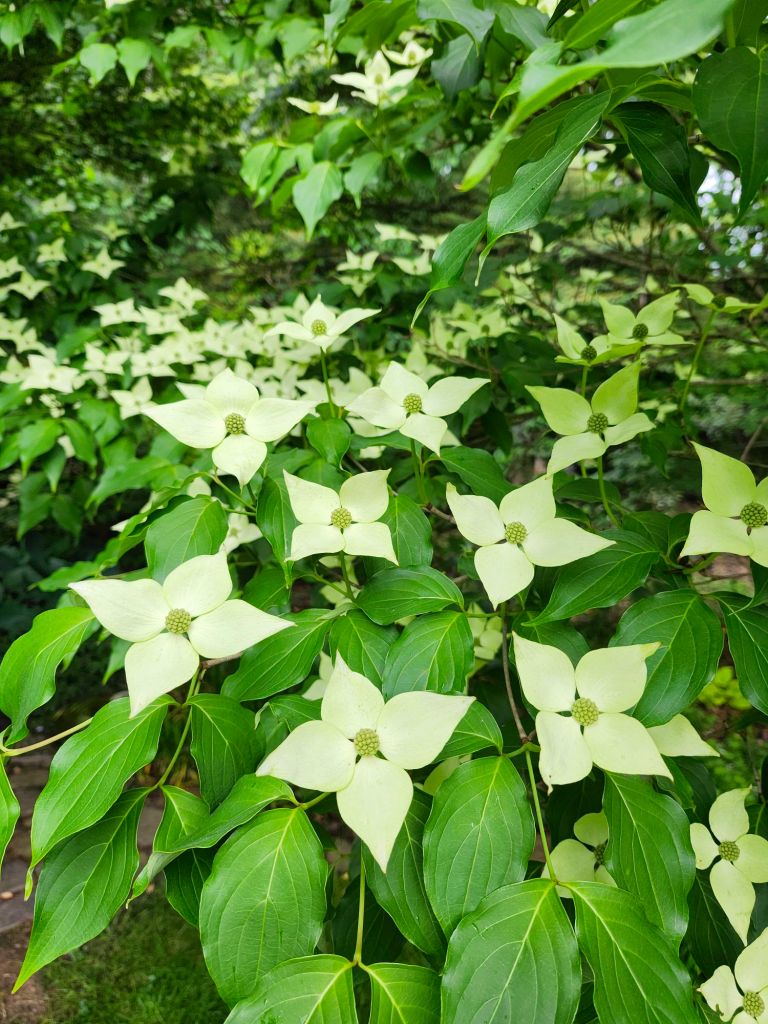The pendulous branching ‘Elizabeth Lustgarten’ dogwood (Cornus kousa ‘Elizabeth Lustgarten’) was surprisingly substantial when purchased by mailorder a year ago. The branches slowly mound to increase its height, but the process to raise its canopy can be hurried along by staking the flexible terminal branch into an upright position (below).

There is no ultimate height that I hope for, but I’ll be happy if it tops out at six feet (it’s now about forty inches tall) some day. Eight would be splendid, but my history in keeping after such projects is spotty. ‘Elizabeth’ is rarely found in garden centers, so I’m quite pleased to have found one and overjoyed that it looks like something so quickly and not just a tiny starter tree.

Flowering of the garden’s native dogwoods was superb, and right on schedule in mid-April. As these faded, the few hybrids bloomed with the exception of the variegated ‘Celestial Shadow’. It has flowered dependably in recent years, so I don’t expect that its shaded positioning is a problem.
To readers who think I exaggerate in mocking the trials and numerous errors in developing the garden, I point to irrefutable evidence that the hybrid ‘Stellar Pink’ dogwood has lost all lower branches so that flowers can no longer be seen on the tall tree. If further confirmation is necessary, the nearby bigleaf magnolia (Magnolia macrophylla) has also lost all lower branches as too many trees have been crammed into too small a space. But, I have little regret and wouldn’t give up one to enable flowering on lower branches on the other.

The star of the hybrid dogwoods is the large, white flowered ‘Venus’ (above). I once predicted this heavy flowering dogwood with huge blooms would take over the market, but it has never been produced in sufficient quantity to gain popularity. Oh well, I have my two, one growing to medium height, but spreading in shape near ‘Celestial Shadow’. The second grows very tall in part sun, and both flower gloriously.
The kousa dogwoods follow into flower as the hybrids are at their peak. From the native dogwoods to hybrids to kousa varieties (Cornus kousa), each has a two week period of prime flowering so that the first dogwood flowers about mid-April and the last fades around the first week of June.


This spring, the variegated ‘Wolf Eyes’ and ‘Samaritan’ have no flower buds, while the upright growing ‘National’ (above) is loaded. It had only a few scattered flowers a year ago, and as the largest of the garden’s kousa dogwoods, it’s flowering more than makes up for the lack of on the others. I have no complaints, and dogwoods with sparse blooms this year are likely to rebound with magnificent flowering a year from now.

I have yet to mention the other dogwoods in the garden. Red and yellow twigged dogwoods flower modestly, with their prime season late autumn and winter when the brightly colored stems of the shrubs shine brightly. I should not have the Pagoda dogwoods (Cornus alternifolia, above) bring up the rear. Two green leafed pagoda dogwoods have grown splendidly in shaded spaces. Both lean slightly towards the light, but they flower nicely, and I hope for an increased number of berries this year.

For me, kousa dogwood is a true four season tree, with beautiful bark and interesting structure in winter, as well as the flowers in spring, lustrous leaves in summer, and (usually) maple-rivalling fall foliage. I’ve never seen a Venus dogwood but your photo makes me want to look for one – seems to be hardy enough for zone 5/6.